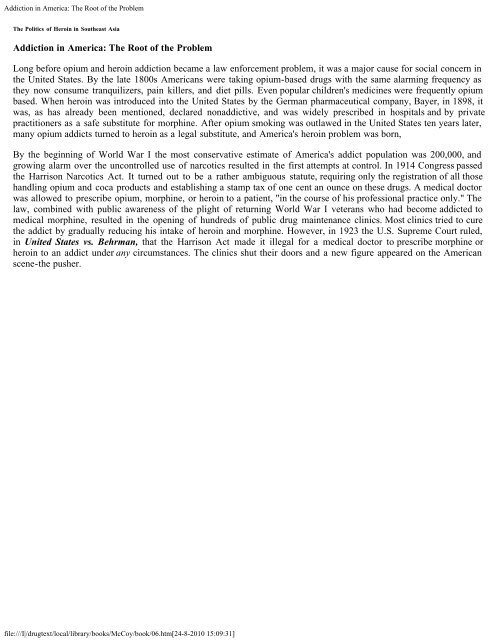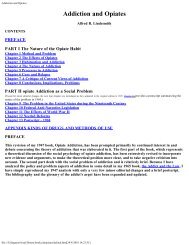- Page 1 and 2: The Politics of Heroin in Southeast
- Page 3 and 4: The Politics of Heroin in Southeast
- Page 5 and 6: The page cannot be found The page c
- Page 7 and 8: Introduction: The Consequences of C
- Page 9 and 10: Heroin: The History of a "Miracle D
- Page 11 and 12: Heroin: The History of a "Miracle D
- Page 13 and 14: The Logistics of Heroin supersonic
- Page 15: Sicily: Home of the Mafia The Polit
- Page 19 and 20: The Mafia Restored: Fighters for De
- Page 21 and 22: The Mafia Restored: Fighters for De
- Page 23 and 24: Luciano Organizes the Postwar Heroi
- Page 25 and 26: Marseille: America's Heroin Laborat
- Page 27 and 28: Genesis The Politics of Heroin in S
- Page 29 and 30: From Underworld to Underground From
- Page 31 and 32: Political Bedfellows: 'The Socialis
- Page 33 and 34: Political Bedfellows: 'The Socialis
- Page 35 and 36: Political Bedfellows: 'The Socialis
- Page 37 and 38: The Guerini-Francisci Vendetta The
- Page 39 and 40: After the Fall to warn them that th
- Page 41 and 42: The Decline of the European Heroin
- Page 43 and 44: The Colonial Legacy: Opium for the
- Page 45 and 46: The Colonial Legacy: Opium for the
- Page 47 and 48: The Colonial Legacy: Opium for the
- Page 49 and 50: The Royal Thai Opium Monopoly as in
- Page 51 and 52: Burma: Sahibs in the Shan States de
- Page 53 and 54: French Indochina: The Friendly Neig
- Page 55 and 56: The Opium Crisis of 1939-1945 The P
- Page 57 and 58: The Meo of Laos: Politics of the Po
- Page 59 and 60: The Meo of Laos: Politics of the Po
- Page 61 and 62: Opium in the Tai Country: Denouemen
- Page 63 and 64: Into the Postwar Era However, in 19
- Page 65 and 66: Cold War Opium Boom Southeast Asia'
- Page 67 and 68:
French Indochina: Opium Espionage a
- Page 69 and 70:
French Indochina: Opium Espionage a
- Page 71 and 72:
French Indochina: Opium Espionage a
- Page 73 and 74:
French Indochina: Opium Espionage a
- Page 75 and 76:
The Binh Xuyen: Order and Opium in
- Page 77 and 78:
The Binh Xuyen: Order and Opium in
- Page 79 and 80:
The Binh Xuyen: Order and Opium in
- Page 81 and 82:
The Binh Xuyen: Order and Opium in
- Page 83 and 84:
The Binh Xuyen: Order and Opium in
- Page 85 and 86:
Secret War in Burma: The KMT contin
- Page 87 and 88:
Secret War in Burma: The KMT the ne
- Page 89 and 90:
Thailand's Opium: The Fruits of Vic
- Page 91 and 92:
Thailand's Opium: The Fruits of Vic
- Page 93 and 94:
Thailand's Opium: The Fruits of Vic
- Page 95 and 96:
APPENDIX: Isn't It True That Commun
- Page 97 and 98:
South Vietnam: Narcotics in the Nat
- Page 99 and 100:
The Politics of Heroin in South Vie
- Page 101 and 102:
Tradition and Corruption in Southea
- Page 103 and 104:
Diem's Dynasty and the Nhu Bandits
- Page 105 and 106:
Diem's Dynasty and the Nhu Bandits
- Page 107 and 108:
The New Opium Monopoly placed beyon
- Page 109 and 110:
The New Opium Monopoly declared in
- Page 111 and 112:
The Thieu-Ky Rivalry The Politics o
- Page 113 and 114:
The Thieu-Ky Rivalry battle for luc
- Page 115 and 116:
The GI Heroin Epidemic The Politics
- Page 117 and 118:
The GI Heroin Epidemic commercial,
- Page 119 and 120:
The Opium Airlift Command The Polit
- Page 121 and 122:
Thieu Takes Command The Politics of
- Page 123 and 124:
The Vietnamese Navy: Up the Creek T
- Page 125 and 126:
The Vietnamese Navy: Up the Creek s
- Page 127 and 128:
The Vietnamese Army: Marketing the
- Page 129 and 130:
The Lower House: Heroin Junkets Vie
- Page 131 and 132:
The Khiem Apparatus: All in the Fam
- Page 133 and 134:
The Khiem Apparatus: All in the Fam
- Page 135 and 136:
The Mafia Comes to Asia The Politic
- Page 137 and 138:
The Mafia Comes to Asia fully, stea
- Page 139 and 140:
The Consequences of Complicity: A G
- Page 141 and 142:
The Consequences of Complicity: A G
- Page 143 and 144:
Hong Kong: Heir to the Heroin Traff
- Page 145 and 146:
Hong Kong: Heir to the Heroin Traff
- Page 147 and 148:
Hong Kong: Heir to the Heroin Traff
- Page 149 and 150:
Hong Kong: Heir to the Heroin Traff
- Page 151 and 152:
Hong Kong: Heir to the Heroin Traff
- Page 153 and 154:
7. The Golden Triangle: Heroin Is O
- Page 155 and 156:
7. The Golden Triangle: Heroin Is O
- Page 157 and 158:
Laos: Land of the Poppy Southeast A
- Page 159 and 160:
Corsican Aviation Pioneers: "Air Op
- Page 161 and 162:
Gen. Phourni Nosavan: "Feudalism Is
- Page 163 and 164:
Gen. Phourni Nosavan: "Feudalism Is
- Page 165 and 166:
Secret War, Secret Strategy in Laos
- Page 167 and 168:
Secret War, Secret Strategy in Laos
- Page 169 and 170:
Secret War, Secret Strategy in Laos
- Page 171 and 172:
Secret War, Secret Strategy in Laos
- Page 173 and 174:
Secret War, Secret Strategy in Laos
- Page 175 and 176:
Long Pot Village: Rendezvous with A
- Page 177 and 178:
Long Pot Village: Rendezvous with A
- Page 179 and 180:
Long Pot Village: Rendezvous with A
- Page 181 and 182:
Gen. Ouane Rattikone: The Vientiane
- Page 183 and 184:
The CIA in Northwest Laos: Prelude
- Page 185 and 186:
The CIA in Northwest Laos: Prelude
- Page 187 and 188:
The CIA in Northwest Laos: Prelude
- Page 189 and 190:
Gen. U Ba Thein: Reaping the Whirlw
- Page 191 and 192:
Gen. U Ba Thein: Reaping the Whirlw
- Page 193 and 194:
The KNIT in Thailand: Guardian at t
- Page 195 and 196:
The KNIT in Thailand: Guardian at t
- Page 197 and 198:
Battle at Ban Khwan: The Challenge
- Page 199 and 200:
Battle at Ban Khwan: The Challenge
- Page 201 and 202:
Battle at Ban Khwan: The Challenge
- Page 203 and 204:
Survival of the Fittest officer at
- Page 205 and 206:
The Shan Rebellion: The Road to Cha
- Page 207 and 208:
The Shan Rebellion: The Road to Cha
- Page 209 and 210:
The Shan Rebellion: The Road to Cha
- Page 211 and 212:
Gen. Ouane Rattikone: Winner Takes
- Page 213 and 214:
Gen. Ouane Rattikone: Winner Takes
- Page 215 and 216:
Gen. Ouane Rattikone: Winner Takes
- Page 217 and 218:
8. What Can Be Done? The Politics o
- Page 219 and 220:
Destroy the Narcotics Syndicates Th
- Page 221 and 222:
Eliminate illicit Opium Production
- Page 223 and 224:
1972: The Year of Decision and brin
- Page 225 and 226:
APPENDIX China: The Historical Sett
- Page 227 and 228:
China Grows Her Own The Politics of
- Page 229 and 230:
The Tarnished Crusades The Politics
- Page 231 and 232:
The Tarnished Crusades endured for
- Page 233 and 234:
The Tarnished Crusades toward the c
- Page 235 and 236:
Glossary The Politics of Heroin in
- Page 237 and 238:
20. Ibid. 21. In 1969 Iran resumed
- Page 239 and 240:
19. Pantaleone, The Mafia and Polit
- Page 241 and 242:
The Politics of Heroin in Southeast
- Page 243 and 244:
42. Le Provencal, November 14, 1947
- Page 245 and 246:
84. Norman Lewis, The Honored Socie
- Page 247 and 248:
15. Shlomo Avineri, Karl Marx on Co
- Page 249 and 250:
50. Ibid., p. 269. 51. Le Thanh Kho
- Page 251 and 252:
89. Interview with Nhia Heu Lynhiav
- Page 253 and 254:
17. Interview with Col. Roger Trinq
- Page 255 and 256:
57. In 1929, for example, out of 71
- Page 257 and 258:
99. The Pentagon Papers, Senator Gr
- Page 259 and 260:
141. David Wise and Thomas B. Ross,
- Page 261 and 262:
185. The New York Times, July 23, 1
- Page 263 and 264:
Needs of the Opium Producing Areas
- Page 265 and 266:
20. Ibid. 21. The Can Lao was a cla
- Page 267 and 268:
60. George Roberts, Report, October
- Page 269 and 270:
103. The Washington Post, July 13,
- Page 271 and 272:
141. All of the following informati
- Page 273 and 274:
167. "The Drug Abuse Problem in Vie
- Page 275 and 276:
206. U.S. Congress, Senate Permanen
- Page 277 and 278:
245. The Washington Post, August 20
- Page 279 and 280:
21. Hong Kong Standard, October 17,
- Page 281 and 282:
61. Interview with an agent, U.S. B
- Page 283 and 284:
19. Ibid. 20. U.S. Bureau of Narcot
- Page 285 and 286:
48. Hong Kong Dispatch #222, from J
- Page 287 and 288:
84. Interview with Maj. Chao La, Ba
- Page 289 and 290:
mass migrations began (interview wi
- Page 291 and 292:
154. When the authors left Long Pot
- Page 293 and 294:
171. Dommen, Conflict in Laos, p. 2
- Page 295 and 296:
208. The Boston Globe, September 3,
- Page 297 and 298:
245. Interview with Jao Nhu, Chiang
- Page 299 and 300:
286. The New York Times, June 6, 19
- Page 301 and 302:
319. Ibid., pp. 40-41. 320. Pacific
- Page 303 and 304:
The Politics of Heroin in Southeast
- Page 305 and 306:
The Politics of Heroin in Southeast
- Page 307 and 308:
31. J. F. Bishop, The Yangtze Valle
- Page 309 and 310:
69. League of Nations, Advisory Com





